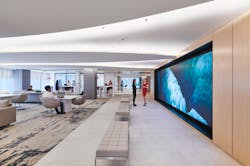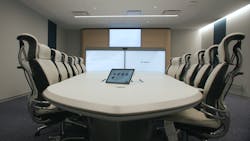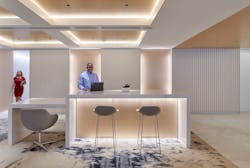Smart Tech Integration Drives Hybrid Work Success
The rise of hybrid work models threw many building owners and managers for a loop. How can we create spaces that enable people’s best work in the office while simultaneously ensuring equity for remote workers? Which amenities will draw people back to the office? And most importantly—how can we revamp our spaces to accommodate hybrid work without overloading the facilities staff, who will ultimately have to execute these decisions?
The answers lie in the intelligent integration of technology and a deep understanding of what your occupants want and need. Tech tools can help you manage spaces more easily and efficiently, while taking the time to study the preferences of people working in the space pays off by ensuring you have the right space types and amenities in place.
Explore how two companies created hybrid-friendly offices outfitted with smart technology.
Cisco’s Smart Space
The new NYC office for tech giant Cisco is a case study on how technology can enable hybrid work models. The company uses its own technology for the One Penn Plaza office, including IoT sensors that gather roughly 5,000 data points on occupancy, space utilization, indoor air quality, temperature and humidity across the 44,000-square-foot space. To support employees working both in and out of the office, the space boasts:
- Cisco DNA Smart Workspaces, which enable organizations to manage space efficiently and minimize energy usage
- Webex Room Kits that provide collaborative conference room experiences, enabling in-office and remote colleagues to work together easily
- Power over Ethernet (PoE) lighting and HVAC
The employees based in this office are 100% hybrid, noted Bob Cicero, Cisco’s Americas Smart Building Leader. Accommodating this switch meant embracing the journey that people take with their work throughout the day. They may spend part of the day in a conference room, then jump into a huddle room for a smaller meeting or use a quiet room where they can sit at a desk.
The One Penn Plaza office has 70% collaborative “we” space and just 30% private “me” space, an inversion of the 30% “we” and 70% “me” that the NYC employees had previously. The office has no less than 92 areas to collaborate with a camera, giving employees a plethora of options and space types for doing in-office work.
“We fundamentally think that if you’re going to do hybrid and build a space to do it, and if you’re going to reposition real estate, that’s an opportunity to start thinking about goals to provide a better end user experience inside a space,” Cicero said.
Cushman & Wakefield Embraces Agile Design
Real estate services firm Cushman & Wakefield centered human connection and interaction for its recently completed Washington, D.C. office, designed by HGA. The new space, which sits on the fifth floor and occupies more than 38,000 square feet, is a study in best-in-class amenities, such as the Arena, a hospitality-driven reception area that features a lounge with a full pantry and a game room. Reservable spaces meet employees’ needs for privacy, collaboration and wellness, while targeted areas can transform to support different office modes, from heads-down to happy hour.
Other amenities include a private courtyard, a rooftop terrace with a conference center and catering kitchen, and a fitness center. These were selected in response to research showing that employees wanted more cross-pollination.
The Washington, D.C. office is currently in phase 1 of its smart building technology journey, observed Adrian Conforti, senior managing director of project and development services for Cushman & Wakefield. The space features daylight harvesting with smart shades and an occupancy dashboard, which helps inform layout and other occupancy-based decisions. Phase 2 may include video upgrades, security or thermal comfort solutions.
The company also uses a smart reservation system that allows users to reserve private or group spaces anywhere across the globe, Conforti said.
How You Can Make a Tech-Assisted Hybrid Model Work
Deploying smart technology in a way that fits your organization can be a big boost as you accommodate hybrid working models. It’s all about having the right tech in the right place.
It all starts with putting in strong infrastructure, said Brad Kult, director of technology services for HGA, which designed Cushman & Wakefield’s Washington, D.C. office. “How are you getting that backbone set up?” Kult asked. “Make sure you have good wireless and cellular technologies so that other technologies can connect to them.”
Next, ensure that all the new tech you’re using can communicate with each other, Kult advised. “You might buy point solutions that only do one thing and don’t work with anybody else’s system,” he said. “If I can’t get that data out of their system, we have to put in another system to do the same thing just to get the data to go somewhere else. Make sure the data is portable, open and accessible.”
Hybrid models work best when technology enables you to communicate transparently with employees too. People will be making decisions about whether to come into the office or not, and the more information you can give them, the better they’ll feel about their decision. This could include how many other people are in the office, noise and light levels, indoor air quality, cleaning frequency and more, Kult said.
“Technology for technology’s sake has never been successful, so we need to focus on the outcomes clients are trying to achieve,” Kult added. “What does a business need that this is addressing? Then we can find the technology to solve that in the best way, rather than saying ‘Hey, cool tech’ and shoehorning it in.”
An outcome-focused approach is key to making hybrid work in your own building, Conforti agreed. Amenities should reflect what tenants want and need; that’s what will draw them to the office and away from the comforts of home.
“Listen to your tenants. They’re the ones who are going to drive this workplace evolution,” Conforti said. “You have to respond to the need out there.”
About the Author
Janelle Penny
Editor-in-Chief at BUILDINGS
Janelle Penny has been with BUILDINGS since 2010. She is a two-time FOLIO: Eddie award winner who aims to deliver practical, actionable content for building owners and facilities professionals.



